#ammachi
Text
Question: Amma, on what form should one meditate? Can one meditate on any form?
Amma: The bond you have forged with a particular deity over lifetimes is in your blood. You need to meditate on the form of that deity only.
Question: How can we discover who that deity is?
Amma: When some people fall down, they spontaneously cry call out "Krishna!" In previous lives, Lord Krishna must have been the ishta devata (the preferred form of divinity) of those who feel more attracted to Lord Krishna than to other divinities. In that case, there's no need for them to meditate on Devi. They need meditate only on Krishna. […] Children, if you have been meditating on the form of Lord Krishna until now, continue with that. You must imagine Him to be one with all other divinities and the embodiment of all divine qualities. If you have been meditating on the form of Devi, continue doing so. Whenever you go to any temple, visualise your ishta devata there. Children, just because your mother's brother calls her "sister" doesn't mean she is not your mother. Everyone's bhavana (imagination) is different. One may address the Lord according to one's bhavana.
In dance dramas, it's the same dancer who wears different costumes to play different roles, isn't it? Is there any change in the man just because he wears different costumes? No. In films, how many characters the same actor plays. However, the actor doesn't change. God can assume any form, but He doesn't change at all. Even if one who meditates on Devi goes to a Krishna temple, it is alright for her to pray "O my Devi!" There is only one Self. The consciousness that inheres in the forms of Devi and Krishna is one. God will appear before us in a form that corresponds to our bhavana. If we imagine God as grass, He will appear before us in such a form. If we envisage him as a stone, He will appear as such, and if we think of Him as a buffalo, He will manifest as one. We can imagine Him in any form we like. The only thing is, we must have faith in that form.
Clay will take the form of the mould into which we pour it, but clay itself does not have any particular form. Even though water appears to take the colour of the bottle into which we pour it, water itself is colourless.
Question: In which spot should we visualise the ishta devata?
Amma: Children, visualise your ishta devata in the lotus of your heart or between your eyebrows. For the householder, the heart lotus is an ideal locus of meditation.
Question: Amma, how should we begin our meditation?
Amma: Visualise your ishta devata from feet to head, and from head to feet, gazing upon each limb in turn. Those who meditate on the form of Krishna should meditate on His feet, anklet, shin, yellow robes, bangles, the flute in His hand, garland of wild flowers, earrings, lips, eyes, crown and peacock feather, and then work your way downwards.
Just as it is done to the idol in the temple, imagine performing abhishekam, the ceremonial bath, to your ishta devata. First do abhishekam with water. Then use milk, sacred ash, sandalwood paste and flowers. Imagine dressing up your ishta devata with fine garments, and adorning Him or Her with ornaments. After that, mentally wave the arati flame before the deity. You can imagine the child Krishna running away, and you as Yashoda, his foster mother, running after Him. It is also good to sit and chant mantras or hymns in praise of your ishta devata. You must open your heart to your ishta devata. Keep crying out, "O Lord! Where are You?"
--Sri Mata Amritanandamayi Devi
2 notes
·
View notes
Text
youtube
Delicious South Indian Crab Gravy Recipe: A Flavorful Seafood Curry with Coconut Milk
#nandu gravy in tamil madras samayal#nandu gravy in tamil amma samayal#nandu gravy in tamil chef damu#nandu gravy in tamil jabbar bhai#nandu gravy in tamil sherin's kitchen#nandu gravy in tamil sangeetha samayal#nandu gravy in tamil sri lanka#nandu gravy in tamil dindigul#nandu gravy in tamil kerala style#nandu gravy in tamil gomathi kitchen#nandu gravy in tamil papa's kitchen#nandu gravy in tamil erode ammachi samayal#nandu gravy in tamil simple#nandu gravy in tamil village style#nandu gravy kerala style#crab gravy kerala style#nandu masala in tamil#nandu masala malayalam#nandu masala recipe in tamil#nandu masala recipe#nandu masala seivathu eppadi#nandu masala gravy#nandu masala amma samayal#nandu masala chettinad#nandu masala home cooking#nandu masala madras samayal#nandu masala chef deena#nandu masala seimurai#nandu masala kulambu#nandu masala nandu masala
0 notes
Note
Hi! I have some news that is really important to me, and there aren't a whole lot of people I can tell about it, so I'm saying it in your ask box, I hope that's okay (my sincerest apologies if not). I'm converting to Judaism, and I'm second-generation Indian American. I found out a couple weeks ago that my family are/were Cochin Jews- after the arrival of Thomas in Kerala, some people converted to Christianity, and my family was a mix of both religions until 1940-ish (1/2)
(2/2) Most of the Jewish members of the family left for Israel, but my maternal great-grandmother, Ammachi, still followed Jewish traditions, albeit in secret, until her death in 2016. I didn't find this out until two weeks ago, and I decided to convert when I was 13 (two years ago). When I told this whole story to a friend of mine at camp, he said "I don't believe in fate, but there really isn't another explanation for that.", and that statement really does sum up my feelings right now.
This is so cool! Thank you for sharing!!
56 notes
·
View notes
Text
A stunning and magisterial new epic of love, faith, and medicine, set in Kerala and following three generations of a family seeking the answers to a strange secret.
Spanning the years 1900 to 1977, The Covenant of Water is set in Kerala, on South India’s Malabar Coast, and follows three generations of a family that suffers a peculiar affliction: in every generation, at least one person dies by drowning—and in Kerala, water is everywhere. The family is part of a Christian community that traces itself to the time of the apostles, but times are shifting, and the matriarch of this family, known as Big Ammachi—literally “Big Mother”—will witness unthinkable changes at home and at large over the span of her extraordinary life. All of Verghese’s great gifts are on display in this new work: there are astonishing scenes of medical ingenuity, fantastic moments of humor, a surprising and deeply moving story, and characters imbued with the essence of life.

#book: the covenant of water#author: abraham verghese#genre: literary#genre: historical fiction#year: 2020s
6 notes
·
View notes
Text

Religious Studies Term Of The Day: Kali
Hey everyone! Sorry for the hiatus. It wasn’t because I was enjoying my vacation and neglecting my duties for the holidays. It’s because I was incredibly sick and social media was the furthest thing from my mind. With that in mind, let’s talk about the goddess Kali!
So, we recently talked about Durga, who was born out of the energy of eight male gods to be a warrior goddess. Well, Kali is one of the gods she then creates from herself. It could even be said that Kali is all of Durga’s bloodthirsty fierceness personified.
While I’m aware that in the internet age, Kali represents female empowerment, which is dope, I agree with Leona M. Anderson’s claim that this was not her original purpose and how she is traditionally seen, even though I love to examine how ideas evolve and are reinterpreted over time. Reading about Kali is so strange and fascinating in a way that feels like I’m in an English class again reading poetry. Every aspect of Kali has poetic purpose to it, from her long tongue to her dark skin to her nakedness and even her long hair and jewelry of death. All of it culminates together into one message that defines her existence: Kali is the mother of human life in the sense that she represents the inevitability of decay and death, that we are born in her innocence and break apart in the cremation fields she calls her home.
Her worshippers, fun fact, sacrifice animals to her because they believe that her female energy is responsibly for holding together our decaying universe and blood is necessary to revitalize her.
Her worshippers would probably also agree with the idea that Kali is complicated. While it is easy to say that she is always malevolent, that’s not necessarily true. There are poems that acknowledge that about her while also remembering why they love her and see her as mother. That’s why I have not even given super detailed explanations about everything in her description and motives because to do so would be to discount the complexity of this figure in totality. I would just encourage people to find some of the poetry and texts written about Kali and see the beautiful prose about what we might consider a terrifying monster of a woman.
As a small example of what I mean, consider how Savitri L. Bess writes about Kali. Specifically, she believes that the goddess Kali walks among us today in the form of a woman named Mata Amritanandamayi, also known as Amma or Ammachi. She is a Guru not known for killing people or dancing around naked and scary looking, but is a woman known throughout the world as one who encourages people of all faiths and classes to love one another with hugs and kisses. That woman is supposedly Kali, the supposedly bloodthirsty goddess of killing and death. Which blows my mind. I studied Amma in my Religions of Asia class and we never even mentioned Kali, and so to discover that in some extra reading and research that wasn’t even about Amma specifically was wild. Truly wild.
Anyway, I’ve rambled long enough in my first post back. I think that this topic is super interesting, but I’m happy to hear other takes and thoughts on Kali as well. For now, I wish everyone a happy holiday season and hope you stay safe.
#religiousstudies#religious studies#religion#religiousliteracy#religions#hindureligion#hindu deities#hindus#hindu#hinduism#women and religious traditions#pamala dicky young#leona m anderson#oxford#Kali#goddess#bloodthirsty#benevolent#factoftheday
2 notes
·
View notes
Text
Every Kannada movies I remember watching
Mohini 9886788888
777 charlie
KGF
KGF 2
Kantara
Bajarangi 2
Drishya 2
Selfie mummy google daddy
Pailwan
Ammachi Yemba nenapu
Mundina Nildaana
Rustum
Bell Bottom
99
Villain
Ambi Ning Vayassayto
Katheyondu Shuruvaagide
Sarkari Hiriya Prathamika Shaale, Kasaragodu, Koduge
Chamak
Rajakumara
Hebbuli
Operation Alamelamma
Kirik Party
Mungaru Male 2
Godhi Banna Saadharna Maikattu
U Turn
Neer Dose
Ricky
Ishtakamya
Kalpana 2
Abhinetri
1st Rank Raju
Rangitaranga
Vaastu Prakara
Ranna
Uggram
6-5=2
Manikya
Dhrishya
Chandralekha
Vastuprakara
Oggarane
Mr. and Mrs. Ramachari
Ulidavaru Kandanthe
Power
Bulbul
Simple agi ondh love story
Tony
Varadhanayaka
Myna
Bachan
Googly
Raja Huli
Lucky
Anna Bond
Chaarulatha
Sangolli Rayanna
Drama
Kalpana
Sidlingu
Kempegowda
Paramathma
Boss (2011)
Hudugaru
Bodyguard
Vishnuvardhana
Aptharakshaka
Just Maath Maathalli
School Master
Naanu Nanna Kanasu
Krishnan Love Story
Jackie
Gaalipata
Mussanjemaathu
Mr. Garagasa
Moggina Manasu
Ganesha Matte Bandha
Milana
Arasu
Cheluvina Chittara
Aishwarya
Mungaru Male
Nenapirali
Magic Ajji
Raktha Kanniru
Abhi
Yajamana
Surya Vamsha
Bhabruvahana
Bhakta Prahalada
Telugu-Tamil
Bahubali
Endiran
RRR
Bahubali 2
Magadheera
Munna
100% Love
Dashavatara
Vaaranam Aayiram
7aum Arivu
Maattrraan
2 notes
·
View notes
Text
Question — Mother, what is maya?
Mother — Whatever doesn't give you lasting peace, that is maya (illusion).
Question — Is this universe maya?
Mother — Yes, the universe is indeed an illusion. Those who get caught in the illusion experience only obstacles and suffering. When you are able to distinguish between the eternal and the transient, you will clearly see that it is all an illusion. We say that the universe is maya. But if we choose only what is positive in our lives, we will not be bound by the illusion. This will help us to progress on the right path. Let us say you are out walking on a muddy ridge between two rice fields, and you slip and fall in the mud. You are covered with mud. To you, the mud is dirt that you want to wash off. But a potter walking that same way sees the mud as something useful. To him, the mud is an excellent type of clay, and he proceeds to use it for his work. To the potter, the mud isn't dirt at all. A woman gathering firewood in a forest comes across a stone. Thinking it is just the right shape, she uses it as a grinding stone. Another person, who knows a lot about stones, sees that same stone and recognizes it as a stone of special quality. He installs the stone in a temple as a divine image. He offers fruits and gems to the deity and worships it. But to those who do not understand its greatness, it is just a stone.You can cook your food on a fire. You can also burn your house down with that same fire. You can sew with a needle. You can also injure your eye with it. To a doctor, a scalpel is an instrument used for surgery to save a patient. To the murderer, it is a lethal weapon. So, rather than dismiss everything as maya, we should consider the real place for each object and use it accordingly. The negative side of things should be dismissed. The great sages saw only goodness in everything in the universe. Those who are fully aware of maya do not succumb to it. They protect the world. On the other hand, those who don't understand maya not only destroy themselves but also become a burden to others. They are committing a form of suicide. If you go through life accepting only the good side of everything, you won't view anything as an illusion. Everything has the potential to lead us to goodness.
--Amritanandamayi
4 notes
·
View notes
Text

The Covenant of Water, a novel by Abraham Verghese, is a fascinating story that takes place mostly in Southern India,1900 to 1977.
Mariamma is only twelve when wed to Appachen, a forty-three-year-old widower. Even though marriage arrangements and its strict stipulations seem strange to the western world, that was the custom in India. In those days, the intended bride and groom normally didn’t even talk to one another beforehand. Her mother claims “the saddest day of a girl’s life is the day of her wedding.” When she arrives in Parambil, land of her husband’s 500 acres, Mariamma is frightened and terribly homesick. However, her husband is a compassionate man who understands Mariamma’s fear and doesn’t approach her as a wife until she matures.
Mariamma becomes a loving companion to Appachen’s two-year old son, Jojo. Together Mariamma and Appachen have two more children, Baby Molay and Philipose. Jojo affectionately calls Mariamma Big Ammachi, meaning Big Mother; his father Big Appachen. Throughout her life, Mariamma will experience unimaginable changes, full of joy and triumph as well as hardship and loss. Her faith, love, and strength sustain her family.
Some families have an affliction called “The Condition,” an aversion to bodies of water. Sometimes victims experience dizziness, headaches, and facial weakness. In Appachen’s family, almost every generation will experience a drowning. In Kerala it’s an inconvenient condition because they are surrounded by water. Appachen will go miles out of his way to travel by land rather than take a much shorter route by boat. The Covenant of Water follows three generations of Appachen’s family who suffer from this affliction.
Reading The Covenant of Water was a commitment, but well worth the effort. The novel is an epic of love, faith, and medicine. It’s hardcover 736 pages involve three generations, two continents, and several geographic locations. Author Abraham Verghese, whose parents were born in India, speaks with authority about life and times in India, and as an American physician is knowledgeable about the medical issues presented in the novel. I recommend The Covenant of Water to anyone seeking to learn about India and another way of life, the consequences of love, and sacrifices made so others may live.
0 notes
Text
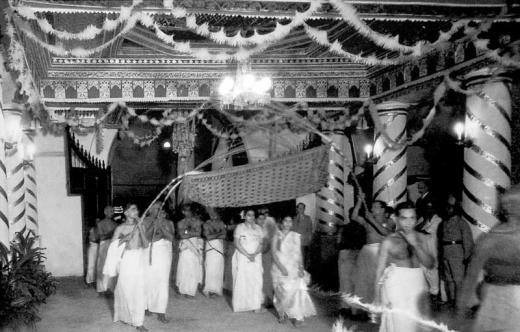
A Royal Wedding - 1934, HH Princess Karthika Tirunal Lakshmi Bayi as a bride under a canopy of red silk held in position by sugarcane in four corners.

Seeking Divine Blessings – 1934. The Royal Bride H H Princess Karthika Tirunal Lakshmi Bayi Visiting Sreekanteswarm Temple.

The Pallikettu of Aswathi Tirunal Gowri Lakshmi Bayi, the Junior Princess of Travancore with vishakham Nal Raja Raja Varma of Paliyakkara in West Palace in 1965.

HH Sethu Lakshmi Bayi with Rama Varma Koil Thampuran on their wedding day (1906)

Her Highness Sri Padmanabha Sevini Vanchi Dharma Vardhini Raja Rajeshwari Rani Bharani Thirunal Lakshmi Bayi, Attingal Mootha Thampuran, Companion of the Order of the Crown of India.
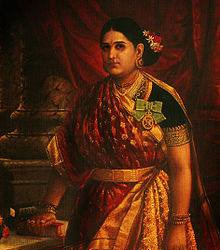
Maharani Bharani Thirunal Lakshmi Bayi CI (1848–1901) was the Senior Rani of Travancore from 1857 till her death in 1901. Her consort was the famous poet and writer, styled the father of Malayalam literature, Sri Kerala Varma Valiya Koil Thampuran.
She died on the 15th of June 1901. As her husband noted in his diary that night,
" My angel, my life, my darling, my all and all, my love, my pride, my idol, my sweetheart- alas! and what not- expired quietly at 8 pm."
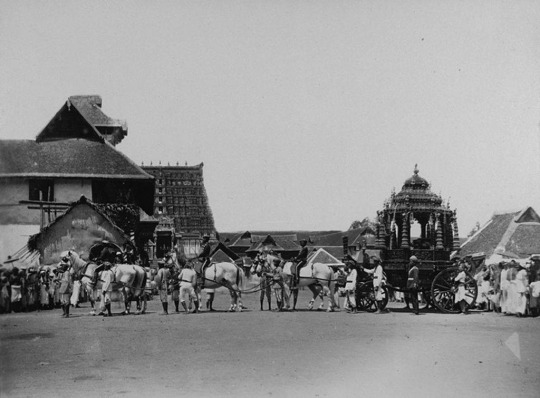
Photograph taken about 1900 by the Government photographer, Zacharias D'Cruz of the Travancore Maharaja's State Carriage in Trivandrum.. It was drawn by a team of six horses. In the background can be seen the gopuram of the Padmanabha Swamy temple.
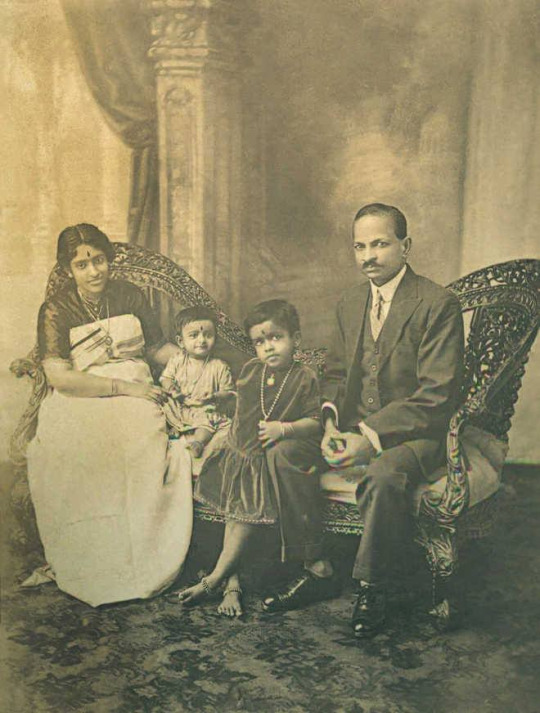
Maharani Sethu Lakshmi Bayi with Her Husband and Princesses Lalitha and Indira.

1928 photograph of Princesses Lalitha and Indira with their mother, the Maharani Regent (Maharani Sethu Lakshmi Bayi).

In Vienna, Austria – 1933. The Travancore Royal Family during their visit to Vienna, Austria. Princess Karthika Tirunal Lakshmi Bayi, Maharani Sethu Parvathi Bayi, Chithira Tirunal Balarama Varma Maharaja and Uthradom Tirunal Marthanda Varma Elayaraja.

Ammachi Panapillai Amma Shrimathi Radhadevi Pandalai - The consort of HH Sree Uthradom Thirunal Marthanda Varma. Very rarely seen. No royal title.
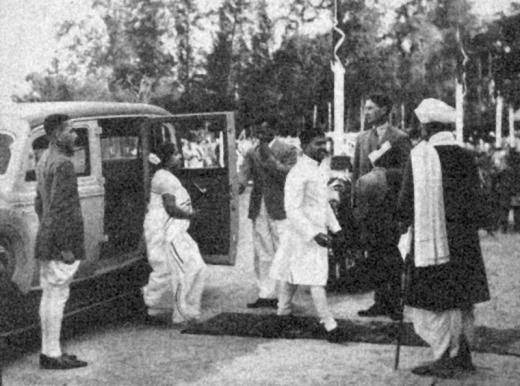
The State of Sports – 1946. H H Chithira Tirunal Balarama Varma Maharaja and H H Maharani Sethu Parvathi Bayi received at the GV Raja Sports School.

Maharani Karthika Tirunal Lakshmi Bayi celebrating her birthday.
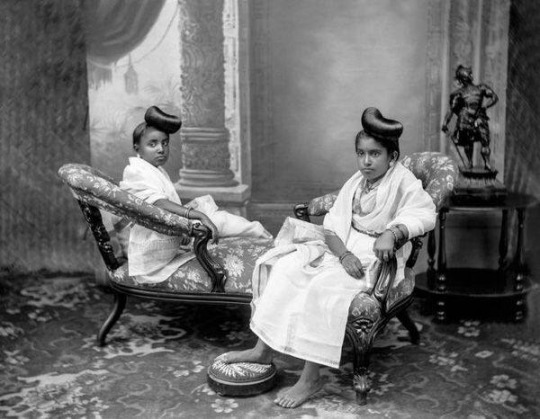
Their Highnesses Maharani Sethu Parvathi Bayi and Maharani Sethu Lakshmi Bayi

The Maharaja and Maharani of Travancore with the Governor of Madras, Lord Erskine, and Lady Erskine at Travancore House, in Adyar, on March 4, 1937, where the Maharaja hosted a party for the Governor. The Dewan of Travancore, Sir C.P. Ramaswamy Aiyer, is seen standing second from left.
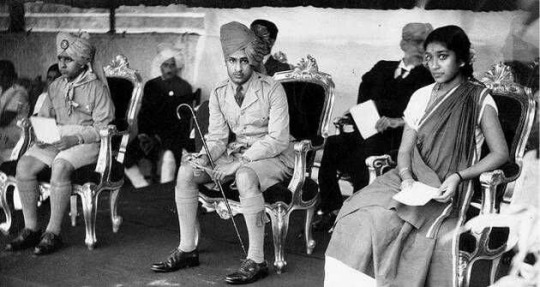
Elaya Raja Marthanda Varma, Travancore Raja Chithira Thirunal and Princess Karthika Tirunal Lakshmi Bayi.

H.H Sree Padmanabha Dasa Chithira Thirunal Bala Rama Varma Maharaja of Travancore, the Last King of Travancore Kingdom and first and only Rajapramukh of Travancore-Cochin State.
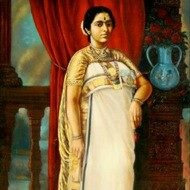
HH Sree Padmanabha Sevini Rajarajaeswari Maharani Sethu Lakshmi Bai Varma, the Queen and Regent of Council- Kingdom of Travancore.
1 note
·
View note
Text
The Covenant of Water
UnCovered Review by Collette Jones, ACLS Egg Harbor City Branch

In 1900, a 12-year-old girl in Travancore, South India, is married off to a 40-year-old widower. She is scared and uncertain, but she knows that she must obey her parents. She sets sail on a boat, leaving her childhood home behind. The girl, who will come to be known as Big Ammachi, grows to love her husband, and they build a life together on their estate, Parambil. Over the next 77 years, Big Ammachi witnesses the birth and death of many family members, as well as the political upheaval of India's independence. She also sees the effects of a family curse that seems to be connected to water: they are haunted, devastated in every generation someone drowns. This book looks into mortality, death and making good decisions. The author reminds us that the beautiful thing about living is the life lived because we and everything else will eventually die. A rose isn’t beautiful because it is a rose it is beautiful because it blooms before it dies.
Dr. Digby Kilgour, a lonely Scottish doctor, flees to India in search of a new life. He soon finds himself caught up in a web of love, betrayal, and scandal. As he struggles to come to terms with his own past, Digby also witnesses the challenges of living in a colonized and segregated society. Through it all, Big Ammachi and Dr. Kilgour are united by their shared humanity. They are both vulnerable and flawed, but they are also capable of great love and compassion. In the end, they find that they are not alone in their struggles. They are all connected by the covenant of water, a bond that transcends time, place, and even death through tears, rivers, and streams they are surrounded.
THE COVENANT OF WATER is a sweeping epic that explores the themes of family, community, and belonging. It is a story of love, loss, and redemption, and it is a reminder that we are all connected, no matter how different we may seem. Through it all, Big Ammachi remains a constant presence. She is a strong and resilient woman who witnesses the best and worst of humanity. She is a reminder that even in the darkest of times, there is always hope. Indian culture, the caste system, British colonialism, illness, poverty intersect in this novel. A lot is going on that needs more attention and explanation. Author Abraham Verghese is a physician. His best writing is when he describes medical conditions, anatomy, surgical procedures, and medical interventions. I would prefer to read a book about the caste system or a book about medical interventions but not in the same novel. The unsuccessful part is that the reader can feel trapped going through over 700 pages. The topics are lively and humorous, but I am left wanting more.
1 note
·
View note
Text
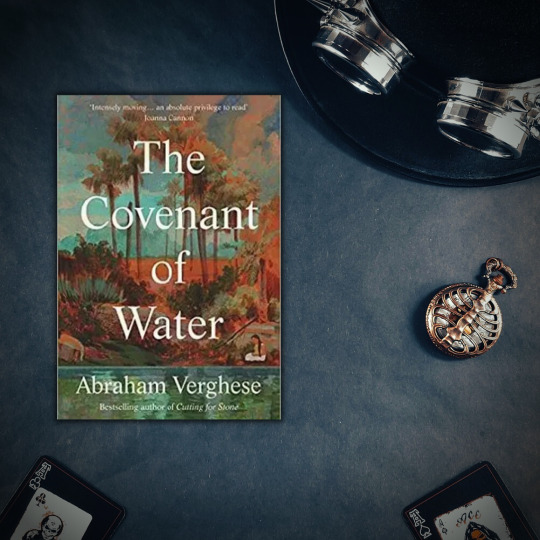
Abraham Verghese’s captivating and expansive novel takes us on a poignant journey that begins with a young girl and her mother in the 1900s Travancore, South India. The girl, soon to be married off to a much older widower, is filled with fear and uncertainty about her future. As her mother drifts off to sleep, leaving her alone, we are transported to the following day and the girl’s voyage away from her childhood home.
Known as Big Ammachi, the girl grows to love her husband, who treats her as the child she is for several years. By the age of 17, she gives birth to her first child, Baby Mol, and they reside on their estate, Parambil, where the labor is carried out by Shamuel, a member of the landless Pulayan caste.
Set in Kerala and spanning the years from 1900 to 1977, “The Covenant of Water” exposes the contradictions of living in a colonized and segregated society. Dr. Digby Kilgour, a lonely individual who fled Scotland for India, discovers that he transitions from being oppressed in Glasgow to becoming an oppressor in India, which depresses him.
“The Covenant of Water” is a splendid and enthralling novel that centers on the human body—what characters inherit and the impact it has on them. The body becomes a vessel for ambiguities and mysteries. Verghese’s medical expertise and meticulous attention to detail, as demonstrated in his international bestseller “Cutting for Stone,” create breathtaking and gripping scenes of survival and medical procedures that linger in the reader’s mind.
Check out the book review here - https://tinyurl.com/2p2c52hd
#booksofinstagram#bookslover#booksbooksbooks#storizenmagazine#bookrecommendations#bookstagram#books#bookreview#bookshelves#bookreviewer#historical fiction#india
0 notes

